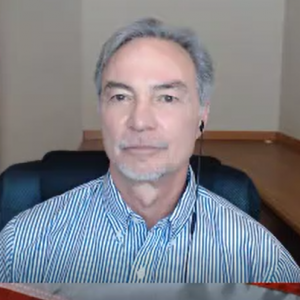Home » Posts tagged 'debt' (Page 19)
Tag Archives: debt
Is the Corporate-Debt Bubble Ripe Yet?
Is the Corporate-Debt Bubble Ripe Yet?
What does it mean when the Fed and other central banks jointly bemoan the effects of their own policies? Worried about not being able to keep all the plates spinning?
This is the transcript from my podcast last Sunday, THE WOLF STREET REPORT:
The Federal Reserve, the ECB, the individual central banks of Eurozone countries, such as the Bundesbank and the Bank of France, the central banks of negative-interest-rate countries outside the Eurozone, such as in Switzerland and Sweden, they’re all now lamenting, bemoaning, and begroaning one of the consequences of low and negative interest rates, the ballooning record-breaking pile of business debts.
This is ironic because these outfits that are now lamenting, bemoaning, and begroaning the pileup of business debts are the ones that manipulated interest rates down via their radical and experimental monetary policies, thereby triggering the pileup of business debts.
This debt pileup isn’t an unintended consequence of their policies. It was one of the purposes of their policies.
But central banks also know from history that this historically high level of business debts is a powder keg waiting to explode – company by company at first, and then as contagion spreads, all at once.
The Fed is a superb example. In its most recent “Financial Stability Report,” released in November, the Fed warns about the historic record-breaking pileup of business debts in the US, as a consequence of low interest rates, and it considers this business debt the biggest risk to financial stability in the US.
But this warning came after the Fed had just cut its policy interest rates three times, and after it had begun to bail out the repo market with over $200 billion so far, and after it had begun buying $60 billion a month in T-bills, in total printing over $300 billion in less than three months, to repress short term rates in the repo market and to bail out its crybaby-cronies on Wall Street – and not necessarily banks – that had become hooked on these low interest rates.
…click on the above link to read the rest of the article…
THE WOLF STREET REPORT: Is the Corporate-Debt Bubble Ripe Yet?
THE WOLF STREET REPORT: Is the Corporate-Debt Bubble Ripe Yet?
What does it mean when the Fed and other central banks jointly bemoan the effects of their own policies? Worried about not being able to keep all the plates spinning? (11 minutes)
Every Bubble Eventually Finds its Pin
Every Bubble Eventually Finds its Pin
The transfer of wealth from workers and savers to governments and big banks continued this week with Swiss-like precision. The process is both mechanical and subtle. Here in the USA the automated elegance of this ongoing operation receives little attention.
NFL football. EBT card acceptance at Del Taco. Adam Schiff’s impeachment extravaganza. You name it. Bread and circuses like these – and many others – offer the American populace countless opportunities for chasing the wild goose.
All the while, and with little fanfare, debts pile up like deadwood in Sequoia National Forest. These debts, both public and private, stand little chance of ever being honestly repaid. According to the IMF, global debt – both public and private – has reached an all-time high of $188 trillion. That comes to about 230 percent of world output.
Certainly, some of the private debt will be defaulted on during the next credit crisis and depression. But when it comes to the public debt, governments do everything they can to prevent an outright default. Central banks crank up the printing press and attempt to inflate it away.
After Nixon temporarily suspended the Bretton Woods Agreement in 1971, the money supply could be expanded without technical limitations. This includes issuing new debt to pay for government spending above and beyond tax receipts. Hence, since 1971, government directed money supply inflation has been the standard operating procedure in the U.S. and much of the world.
Downright Disgraceful
Expanding the money supply has the effect of dissipating wealth from the currency. The process allows governments, which are first in line to spend this newly created money, a back door into your bank account. Without levying taxes, they get access to your wealth and future earnings and leave you with money of diminished value.
…click on the above link to read the rest of the article…
Shale’s Debt-Fueled Drilling Boom Is Coming To An End
Shale’s Debt-Fueled Drilling Boom Is Coming To An End

The financial struggles of the U.S. shale industry are becoming increasingly hard to ignore, but drillers in Appalachia are in particularly bad shape.
The Permian has recently seen job losses, and for the first time since 2016, the hottest shale basin in the world has seen job growth lag the broader Texas economy. The industry is cutting back amid heightened financial scrutiny from investors, as debt-fueled drilling has become increasingly hard to justify.
But E&P companies focused almost exclusively on gas, such as those in the Marcellus and Utica shales, are in even worse shape. An IEEFA analysis found that seven of the largest producers in Appalachia burned through about a half billion dollars in the third quarter.
Gas production continues to rise, but profits remain elusive. “Despite booming gas output, Appalachian oil and gas companies consistently failed to produce positive cash flow over the past five quarters,” the authors of the IEEFA report said.
Of the seven companies analyzed, five had negative cash flow, including Antero Resources, Chesapeake Energy, EQT, Range Resources, and Southwestern Energy. Only Cabot Oil & Gas and Gulfport Energy had positive cash flow in the third quarter.
The sector was weighed down but a sharp drop in natural gas prices, with Henry Hub off by 18 percent compared to a year earlier. But the losses are highly problematic. After all, we are more than a decade into the shale revolution and the industry is still not really able to post positive cash flow. Worse, these are not the laggards; these are the largest producers in the region.
…click on the above link to read the rest of the article…
Debt Bubble to End All Bubbles – Michael Snyder
Debt Bubble to End All Bubbles – Michael Snyder
Journalist and book author Michael Snyder says corporate debt is at record highs standing at $10 trillion. Snyder points out debt is setting records in every aspect of the economy and contends, “If you include all other forms of corporate debt not listed on the stock exchanges, that brings the total to $15.5 trillion, which is equivalent to 74% of GDP. We’ve never seen anything like this before in all of U.S. history. That is just one form of debt and how our society has grown the debt. People need to realize the only reason why we have any prosperity in this country today is because it is fueled by debt. We have been building up this bubble, and it is the bubble to end all bubbles. Look at consumers. U.S. consumers are now $14 trillion in debt, which is an all-time record. State and local governments are at all-time debt record levels. The U.S. government . . . we just hit $23 trillion in debt, more than double since the last financial meltdown. . . . We are stealing from future generations more than $100 million every single hour of every single day. This is a crime beyond comprehension, and it’s been going on more than a decade. . . .All the debt has bought for us is more time to expand the bubble for relative stability. Meanwhile, we are literally committing national suicide and literally destroying the future of this country and the future of this republic. We are destroying everything the founders built by insatiable greed in this generation.”
Snyder says you don’t have to wait for the next recession because it’s already started. Snyder says, “Eventually, this whole thing is going to come crashing down. This thing is not sustainable. Here in the United States, we are already in a manufacturing recession. We are already in a transportation recession.
…click on the above link to read the rest of the article…
Ex-BOJ Chief Regrets Not Hiking, Hated QE, Says Sub-1% Interest Rates Don’t Work
Ex-BOJ Chief Regrets Not Hiking, Hated QE, Says Sub-1% Interest Rates Don’t Work
Things are going from bad to worse in Japan: 7 years after BOJ chief Kuroda launched QQE (subsequently with yield curve control) while monetizing tens of billions in ETFs, the central banks has failed to boost either Japan’s economy or its inflation, both a dismal byproduct of Japan’s record debt load. So now that the BOJ has failed to remedy what was the consequence of massive debt loads, Japan has a cunning plan: unleash another tsunami of debt.
According to the Japan Times, Japan is set to “re-embrace the power of public spending” – because apparently the country with the world record setting 250% debt/GDP somehow did not embrace public spending before – with one of its biggest ever stimulus packages. Pointing to slowing global growth, a higher sales tax and a string of natural disasters, policymakers in Tokyo are the latest to join the worldwide shift toward a double-barreled approach of supporting the economy through fiscal measures and ultraloose monetary policy, which as we have noted before is a preamble to MMT and full-blown debt monetization by the government.
That’s good news for the Bank of Japan, which has “appeared” (but only appeared, because it now owns so many of Japan’s ETFs it has to start lending them out to prevent a market freeze) reluctant to ramp up its own massive stimulus program, as it strains at the limits of effectiveness.
As a result, in less than a month, expectations in Japan for a “modest” stimulus package with a face value of ¥5 trillion ($46 billion) have quadrupled to ¥20 trillion, despite having the developed world’s largest public debt load. And there is much more to come.
…click on the above link to read the rest of the article…
What’s Behind the Subprime Consumer Loan Implosion?
What’s Behind the Subprime Consumer Loan Implosion?
These are the good times, but why are subprime credit cards, auto loans, and short-term installment loans blowing out?
This is the transcript from my podcast last Sunday, THE WOLF STREET REPORT:
OK, we’ve got a situation in subprime consumer loans. The delinquency rate on credit-card loan balances at the nearly 5,000 smaller commercial banks in the United States – this means all banks except the largest 100 – is blowing out, according to Federal Reserve data. In the third quarter, the delinquency rate at these banks rose to 6.25%. That’s higher even than during the peak of the Financial Crisis.
Back in 2016, the credit-card delinquency rate at these banks was in the 3% range. It has more than doubled in two years.
Credit card balances are considered delinquent when they’re 30 days or more past due. This delinquency rate means that out of the banks total credit card balances, 6.25% are 30 days or more past due. This is a disturbingly large rate.
But delinquencies are a flow. Balances are removed from the delinquency basket either when the customer cures the delinquency, such as catching up with past-due payments, or when the bank “charges off” the delinquent balance against its loan loss reserves. But as these delinquent balances were taken out of the delinquency basket, even more new delinquencies fell into the basket, and the delinquency rate rose.
Subprime auto loans have also been blowing out. In the third quarter, the serious delinquency rate of the $1.3 trillion in auto loans has risen to 4.71%, the highest since the worst months of the Financial Crisis, when the auto industry collapsed, and when the US was facing the worst unemployment crisis since the Great Depression. In the third quarter, about 21% of all subprime auto loans were seriously delinquent – meaning 90 days past due.
…click on the above link to read the rest of the article…
Peak Irony: Fed Paper Admits Fed Policy Can Lead to Economic Ruin
Peak Irony: Fed Paper Admits Fed Policy Can Lead to Economic Ruin

A paper by Scott A. Wolla and Kaitlyn Frerking for the Federal Reserve Bank of St. Louis warns that the Fed’s own policy could lead to “economic ruin.”
The paper titled “Making Sense of National Debt” explains the pros and cons of national borrowing in typical Keynesian fashion. In a nutshell, a little debt is a good thing, but too much debt can become a problem.
But in the process of explaining national debt, Wolla and Frerking stumble into an ugly truth — Federal Reserve money printing can destroy a country’s economy.
So, when does the national debt become a problem?
According to Wolla and Frerking, debt only becomes an issue when it outpaces GDP, or national income, as they call it. If debt grows at a faster rate than income, eventually the debt might become unsustainable.
They note that according to the GAO, the US national debt is on an unsustainable path.
The federal debt is projected to grow at a faster rate than GDP for the foreseeable future. A significant portion of the growth in projected debt is to fund social programs such as Medicare and Social Security. Using debt held by the public (instead of total public debt), the debt-to-GDP ratio averaged 46 percent from 1946 to 2018 but reached 77 percent by the end of 2018. It is projected to exceed 100 percent within 20 years.”
Note that the total public debt is even higher. Most analysts put the total debt to GDP ratio at around 105%.
As Wolla and Frerking point out, rising levels of debt elevate the risk of default. Normally, investors holding government bonds bear this risk. While governments never have to entirely pay off debt, there are debt levels that investors might perceive as unsustainable.
…click on the above link to read the rest of the article…
Chinese Media Stunner: China Will Be The Next Country To Cut Rates To Zero
Chinese Media Stunner: China Will Be The Next Country To Cut Rates To Zero
One week ago, we showed in one chart why the global economic recovery that so many expect is just a few months away, won’t happen: as the chart below shows, China’s credit intensity since 1994 has exploded. This means that before the Global Financial Crisis, China needed on average one unit of credit to create one unit of GDP. Since 2008, 2½ units of credit are required to create one unit of GDP. In other words, that China needs much more credit than 10 years ago to have the exact same amount of GDP. Injecting more credit in the economy is not the miracle solution it used to be, and the disadvantages of credit push tend to surpass the advantages.
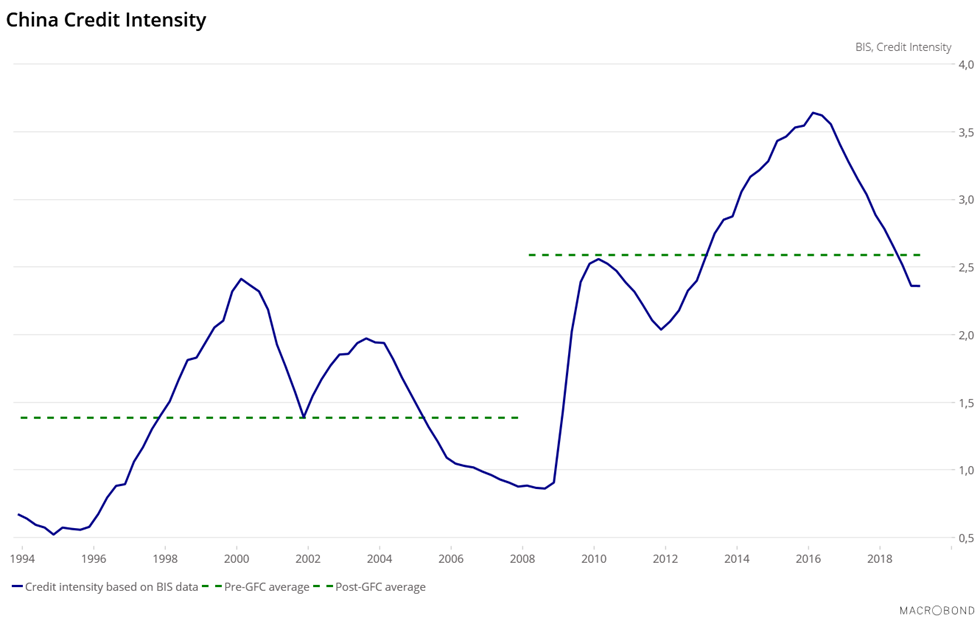
This explosion in China’s credit intensity in the past decade has directly fueled China’s debt engine, the same debt engine that single-handedly pulled the world out of a global depression in 2008/2009. Alas, this will not happen again: China’s public and household debts are at their highest historical levels, respectively at 51% of GDP and 53% of GDP, and the private sector debt service ratio is becoming a burden for many companies, reaching on average 19.7% This records an increase from 13% before the crisis. Overall, China’s debt to GDP is fast approaching an unprecedented 320%!
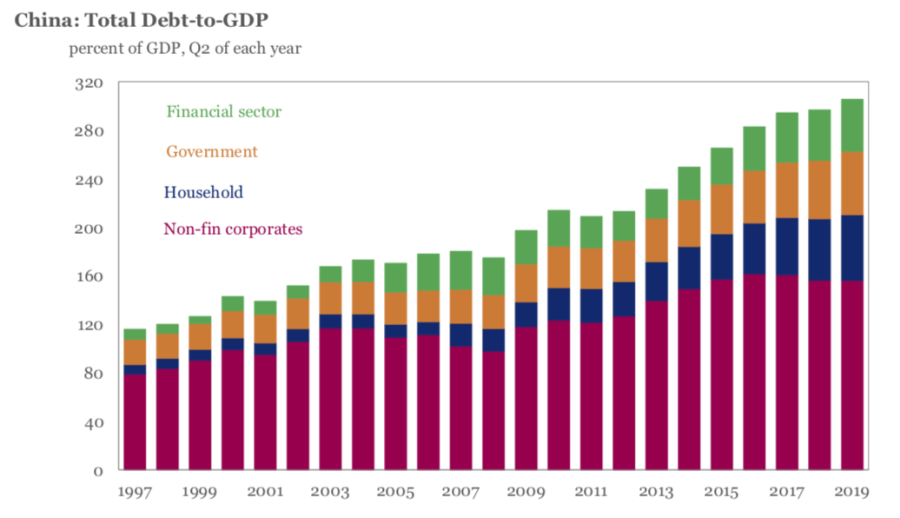
Which brings us to Saxo’s dour conclusion for all those who believe that the global economy is about to enjoy another period of sustainable growth (and has confused the Fed’s QE for economic resilience and fundamentals):
Contrary to previous periods of slowdown, notably in 2008-2010, 2012-2014 and in 2016, China is unlikely to save the global economy once again.
…click on the above link to read the rest of the article…
What Happens After The Economic Momentum Ends?
What Happens After The Economic Momentum Ends?
At Some Point We Have Simply Overbuilt!
The economic landscape before us continues to look like something out of “Alice And The Looking Glass”. A bizarre and unrecognizable land, a land that is distorted and papered over by ream after ream of paper. For over a decade this paper has been rolling off the printing presses of central banks all across the world in an attempt to mask reality. Peter Schiff says, printing money is to the economy what taking drugs is to a drug addict. In the short term, it makes the economy feel good, but in the long run, it is much worse off. Unfortunately, what was once the “long-run” or “distant future” is now getting much closer.
Many people are now set to blame any slowdown in global growth on what has been declared avery dangerous and protracted trade war. Going into it many economists warned it could be truly disastrous for the entire global economy. In my opinion, the fear of slowing trade and how it will affect America is being overplayed and is not the chief catalyst for a slowdown here in America. While it is easy to target trade as the culprit and Trump as the instigator this conclusion is not supported by facts. We should remember the economy moves in cycles and this one is long in the tooth by historical standards.
Since the Bernanke experiment began, time and time again, the green shoots of economic growth have withered and required more stimulus in order to move to the next level. Each prediction of achieving escape velocity has proven to be short-lived or overly optimistic. These bursts of good news have continually been followed by disappointing economic data forcing some kind of stimulus to get the economy over the next hurdle.
…click on the above link to read the rest of the article…
Fed Fears Next Crash Fatal – John Rubino
Fed Fears Next Crash Fatal – John Rubino
Financial writer and book author John Rubino says he can see the end of the economic expansion fueled by massive debt creation. Rubino explains, “Every sector of the U.S. economy is so over indebted I don’t see how we go on much longer. The Fed is desperately trying to prolong this thing. We are running trillion dollar deficits now, and what that is for is to keep the system from falling apart. We are 11 years into an expansion, a record. This is the longest bull market in history, and this is the longest economic expansion in history. . . . These guys don’t know exactly what’s going to happen in the next recession, but they are afraid that the system is so highly leveraged that even a garden variety three quarters of a percent of negative growth and a garden variety of 20 % drop in stock prices might be fatal. The system might not be able to handle that because it would cause so much damage and there are so many different places that can blow up that the system would spin out of control. We would get 2008-2009 again but on steroids because the numbers are so much bigger this time around. So, they want to avoid that at all costs.”
Rubino points out, “Fear is the enemy in a fiat currency system. Everything is based on our assumption that the guys in charge know what they are doing and that the confidence in them is good. You take that away, and they let us see them sweat, and it’s over. There is no real bottom for the dollar, euro or the yen. Their intrinsic value is zero.
…click on the above link to read the rest of the article…
Global Debt To Hit All Time High $255 Trillion, 330% Of World GDP
Global Debt To Hit All Time High $255 Trillion, 330% Of World GDP
There are three certainties in life: death, taxes and that global debt will keep rising in perpetuity.
Addressing the third, yesterday the Institute of International Finance reported that global debt has now hit $250 trillion and is expected to hit a record $255 trillion at the end of 2019, up $12 trillion from $243 trillion at the end of 2018, and nearly $32,500 for each of the 7.7 billion people on planet.
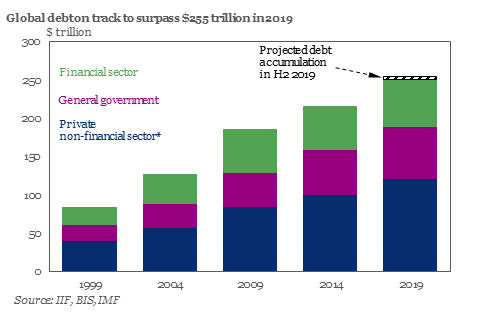
“With few signs of slowdown in the pace of debt accumulation, we estimate that global debt will surpass $255 trillion this year,” the IIF said in the report.
The surge was driven by a $7.5 trillion surge in the first half of the year which was used to reverse the global slowdown that sent stocks into a bear market in 2018, and which shows no signs of slowing. Around 60% of that jump came from the United States and China. Government debt alone is set to top $70 trillion this year, as will overall debt (government, corporate and financial sector) of emerging-market countries.
The total debt breakdown as of Dec. 31 is as follows:
- Household debt: $47.9 trillion
- Non-financial corporate: $75.7 trillion
- Government: $70 trillion
- Financial corporate: $61.7 trillion
And this is what the total debt picture was like at the start of the century, 20 years ago…
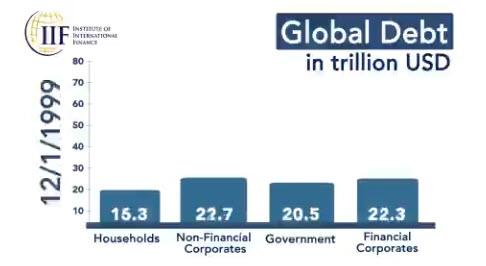
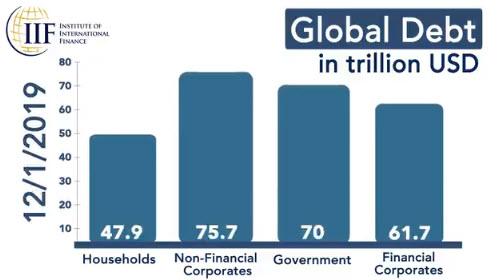
This amounts to a grand total of just over $255 trillion, roughly equivalent to a record 330% of global GDP.
WATCH: Follow the increase of global #debt over two decades.
Latest IIF Global Debt Monitor finds global debt has now surpassed a record $250T & is projected to reach $255T by the end of 2019. pic.twitter.com/D001VVzZmD— IIF (@IIF) November 14, 2019
Separately, Bank of America’s Michael Hartnett on Friday calculated that since the collapse of Lehman, government debt has increased by $30tn, corporates debt by $25tn, household by $9tn, and financial debt by $2tn; And with central banks expected to support government debt, BofA warns that “the biggest recession risk is disorderly rise in credit spreads & corporate deleveraging.”
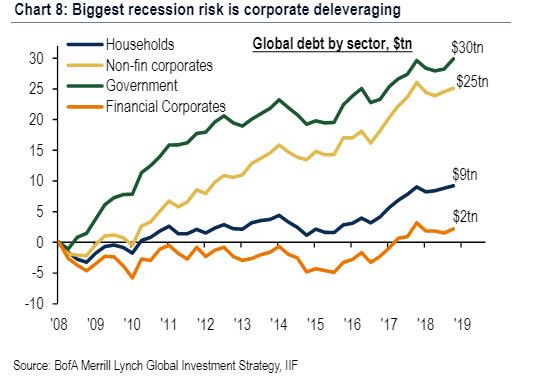
The Federal Reserve Is Directly Monetizing US Debt
The Federal Reserve Is Directly Monetizing US Debt
In a very real way, MMT is already here
Sure, it’s not admitting to this. And it’s using several technical jinks and jives to offer a pretense that things are otherwise.
But it’s not terribly difficult to predict what’s going to happen next: the Federal Reserve will drop the secrecy and start buying US debt openly.
At a time, mind you, when US fiscal deficits are exploding and foreign buyers are heading for the exits.
How It’s Supposed to Work
Here’s how it’s supposed to work when the US government issues new debt:
- If the US Treasury needs to raise new funds, it announces an upcoming auction of US Treasury bills/notes/bonds.
- A date for the auction is set.
- Various participants bid for those bills/notes/bonds (including ‘regular folks’ like you and me if we’re using the government’s Treasury Direct program).
- At a later date, the Fed can buy those US Treasury bills/notes/bonds. The various holders of that debt submit offers to sell, and the Fed (presumably) selects the best offers on the best terms.
The Federal Reserve, under no conditions, buys Treasury paper directly. The Federal Reserve’s own website still maintains that this is the case:

There are two important claims plus one assertion I’ve highlighted in there, each in a different color:
- Yellow: Treasury securities may “only be bought and sold in the open market.”
- Blue: doing otherwise might compromise the independence of the Fed.
- Purple: the Fed mostly buys “old” securities.
So according to the Fed: it’s independent, it follows the rules set forth in the Federal Reserve Act of 1913, and it mostly buys “old” Treasury paper that the market has already properly priced in a free and fair system.
But that’s not really what’s going on…
…click on the above link to read the rest of the article…
World Debt Downgrade Warning – Moody’s
World Debt Downgrade Warning – Moody’s

◆ A World Debt Downgrade Warning (WDDW) has been issued by credit rating agency Moody’s due to deepening global geopolitical uncertainty and risks
◆ Moody’s has issued a debt downgrade warning to the entire world on fears that severe political turmoil from London to Hong Kong poses a threat to the global economy (see News below)
◆ Moody’s have a bleak outlook for government debt amid political instability in a report published just this Monday
◆ Moody’s said political and geopolitical turbulence is exacerbating a slowdown in national and global GDP growth, aggravating structural ‘bottlenecks’ centred on massive banking and sovereign debt and increasing the risk of economic or financial shocks
◆ Moody’s identified the emergence of influential “populist” movements and suggested this is undermining the effectiveness of domestic policy, weakening institutional strength and compounding social and governance risks
◆ “Overall, the global environment is becoming less predictable for the 142 sovereigns we rate, encompassing $63.2 trillion in debt outstanding,” according to the report
NEWS and COMMENTARY
Moody’s issues debt downgrade warning to the entire world
Moody’s offers bleak outlook for government debt amid political instability
Moody’s has negative outlook for sovereigns
Gold firms as doubts over U.S.-China trade deal curb risk appetite
China likely to ‘intervene’ in Hong Kong’s affairs more following the protests (BAML)Trump says China trade deal ‘close’ but dashes hopes for signing details
Global trade is likely contracting and we’re now ‘betting’ on a US-China deal, OECD chief says
China’s gold-backed crypto looming as ‘Pearl Harbor type event’ for US dollar in 2020 – Keiser Report

GOLD PRICES (LBMA – USD, GBP & EUR – AM/ PM Fix)
12-Nov-19 1455.00 1452.05, 1134.03, 1130.42 & 1319.69 1318.17
11-Nov-19 1465.50 1458.70, 1144.41 1132.39 & 1328.33 1321.87
08-Nov-19 1466.85 1464.15, 1144.58 1142.62 & 1328.09 1328.13
07-Nov-19 1484.10 1484.25, 1153.44 1156.82 & 1339.40 1341.76
06-Nov-19 1488.55 1486.05, 1155.26 1154.51 & 1342.23 1341.31
05-Nov-19 1504.60 1488.95, 1166.37 1156.17 & 1352.18 1344.67
04-Nov-19 1509.20 1509.45, 1168.57 1169.52 & 1352.39 1353.98
01-Nov-19 1509.85 1508.80, 1165.76 1164.49 & 1354.79 1351.28
31-Oct-19 1506.40 1510.95, 1163.09 1168.57 & 1348.53 1356.53
Now That We’ve Incentivized Sociopaths–Guess What Happens Next
Now That We’ve Incentivized Sociopaths–Guess What Happens Next
As long as central banks create and distribute trillions in conscience-free credit to conscience-free financiers and corporations, the incentives for sociopathy only increase.
“Sociopath” is a word we now encounter regularly in the mainstream media, but what does it mean?
Here is a list of 16 traits, many of which are visible in lionized corporate and political leaders and entrepreneurs.
One key trait is a lack of moral responsibility or conscience; the sociopath feels no remorse if he/she takes advantage of people or exploits them.
Sociopaths are masters of superficial charm, intelligence and confidence, and adept at massaging or misrepresenting reality up to and including outright lying to persuade others or get their way.
Like all psychological syndromes (manic depression, autism, bipolar disorder, etc.), there is a wide spectrum of sociopathological traits, some of which may offer some adaptive benefits (and hence their continued presence in the human genome). In other words, an individual can have a few of the traits in greater or lesser proportions.
Thus the modern BBC Sherlock Holmes (played by Benedict Cumberbatch) describes himself as a “high-functioning sociopath” (though many contest this diagnosis of the original Holmes in Arthur Conan Doyle’s stories).
Anyone who has read Walter Isaacson’s biography of Steve Jobs can readily see manifestations of sociopathy in Jobs: his famous “reality distortion field,” his refusal to accept that he’d fathered a daughter, his lack of empathy, his wild emotional swings (from verbal abuse to weeping), his dietary extremes, his charm, so quickly turned on or off, his uneven parenting, and so on. His obsessive-compulsive behavior was also on full display. Yet Jobs is lauded and even worshiped as a genius and unparalleled entrepreneur. Was this the result of his sociopathological traits, or something that arose despite them?
…click on the above link to read the rest of the article…




